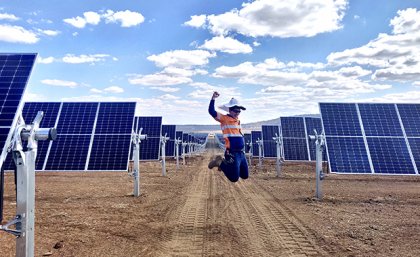When completed, the University of Queensland’s (UQ) 64 MW Warwick Solar Farm could make it the worlds’ first university to offset 100% of its electricity from its own renewable energy asset. As completion of the large-scale project looms, so too does the notoriety of the feat, signalled by the project claiming the Australasian Green Gown Award for commitment to sustainability in the inaugural 2030 Climate Action Category.
UQ purchased the project last November as part of its plan to offset 100% of its electricity needs with renewables by 2020.
Acting Vice-Chancellor Aidan Byrne said UQ was proud to be recognised as a leader in the sector via the awards, which recognises exceptional sustainability initiatives. “We’re at a moment in history when the decisions we make, in my view, will determine the future well-being of humanity, and we must stop saying that individual action will not make a difference,” Professor Byrne said.
Byrne, whose academic expertise is in the hard sciences, was in a rather philosophic mood when UQ received news of its award, “Society is largely built on the cumulative effect of small acts,” said Byrne. “When it comes to climate change, we all share the responsibility and the consequences, and so we all need to make sure that we are doing our bit.”
UQ Energy & Sustainability Manager Andrew Wilson recently reported on the progress of the project, noting that the installation of panels had already been completed. “The University now has about 200,000 solar panels with 64MW of capacity, and we remain on track to commence power generation in the first quarter of 2020,” said Wilson. “Work on site is now focused on connecting everything together, to be followed by testing and commissioning of all parts of the system.”
UQ is not only going to benefit economically with the generation of its own solar energy, the university is also going to utilise the project to improve its research capabilities in renewables.
“We’re thinking deeply about how to overcome the barriers that might slow the switch from a fossil fuel dominated energy system, including in developing countries such as China and India,” said Byrne.
UQ calculates the utility-scale solar farm will pay for itself over the life of the project through electricity savings against a large amount of energy it uses to power laboratories, lecture theatres, libraries and other facilities for its 52,000 students and thousands of staff.
Its plan is to sell excess energy generated by the farm into the National Electricity Market, helping to put downward pressure on wholesale energy prices for all consumers, while a PPA with a third party is also on the cards. For backup power, UQ will need to be exposed to the 30 minute wholesale energy market ‘spot price’. It is planning to manage a risk of market volatility through specialist financial hedging instruments such as ‘cap’ contracts.
In the long run, UQ may even consider getting further off the grid, as its Warwick solar farm is designed to be battery storage-ready. In the meantime, the University is pursuing opportunities for energy storage ‘behind the meter’ alongside its 50,000 modules already in place at its campuses, including a 1 MW/2 MWh of lithium-ion storage at the St. Lucia campus, as well as the 600 kW/760 kWh of lithium-ion battery at the Gatton campus.
This content is protected by copyright and may not be reused. If you want to cooperate with us and would like to reuse some of our content, please contact: editors@pv-magazine.com.









By submitting this form you agree to pv magazine using your data for the purposes of publishing your comment.
Your personal data will only be disclosed or otherwise transmitted to third parties for the purposes of spam filtering or if this is necessary for technical maintenance of the website. Any other transfer to third parties will not take place unless this is justified on the basis of applicable data protection regulations or if pv magazine is legally obliged to do so.
You may revoke this consent at any time with effect for the future, in which case your personal data will be deleted immediately. Otherwise, your data will be deleted if pv magazine has processed your request or the purpose of data storage is fulfilled.
Further information on data privacy can be found in our Data Protection Policy.